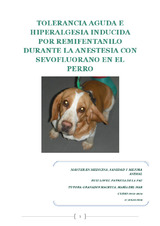Tolerancia aguda e hiperalgesia inducida por remifentanilo durante la anestesia con sevofluorano en el perro
Autor
Ruiz López, Patricia de la Paz
Tutor
Granados Machuca, María del MarEditor
Universidad de CórdobaFecha
2016Materia
ToleranciaHiperalgesia
Remifentanilo
Opioides
Perros
Tolerance
Hyperalgesia
Remifentanil
Opioids
Dogs
METS:
Mostrar el registro METSPREMIS:
Mostrar el registro PREMISMetadatos
Mostrar el registro completo del ítemResumen
Se ha relacionado el remifentanilo con la hiperalgesia inducida por opioides (HIO) y tolerancia en ratas, lo cual produce una disminución en la reducción de sevofluorano. Esta disminución en la CAM de sevofluorano sugiere tolerancia aguda a opioides (TAO). El objetivo de este estudio es determinar si se puede desarrollar tolerancia aguda a opioides que limite la reducción de concentración alveolar mínima (CAM) de sevofluorano. La respuesta a estímulos nociceptivos mecánicos es evaluada y relacionada a HIO.
Se evalúan mediante estímulos nociceptivos mecánicos (NMT) perros beagles, tras lo que se realiza anestesia con sevofluorano y 50% O2, se monitorizan y ventilan mecánicamente. Se determina la CAM de sevofluorano (CAMb1), tras lo que se administra remifentanilo (N=9) o salino (N=9) intravenoso. Veinte minutos después se determina de nuevo la CAM de sevofluorano (CAMpostfarm1) y treinta minutos después de la CAMpostfarm1 se determina la CAMpostfarm2. Una semana después, se determina la CAMb2. El NMT se determina a los 3 y 7 días de la primera anestesia para evaluar la HIO. Se considera TAO un aumento estadísticamente significativo de la CAMpostfarm2 respecto a la CAMpostfarm1 de sevofluorano. Hiperalgesia es considerada si hay una disminución del NMT a los días 3 y 7 y/o un aumento en la CAMb2 respecto a la CAMb1.
La infusión continua de remifentanilo reduce la CAMpostfarm1 a 1.54±0.23% (43.7%). No se encuentran diferencias significativas entre la CAMpostfarm2 respecto a la CAMpostfarm1 ni en el grupo de salino (p 0.104) ni en el de remifentanilo (p 0.389). Tampoco se hallan entre la CAMb1 y CAMb2 (p 0.818) o entre RSb, RS3 y RS7 en ambos grupos.
El remifentanilo induce tolerancia aguda en ratas; pero, en perros, la eficacia en reducir la CAM de sevofluorano no disminuye, sugiriendo que no se induce TAO. Ni produciéndose hiperalgesia en una semana. Remifentanil has been related to the development of opioid-induced hyperalgesia (OIH) and tolerance in rats, which, in turn, may produce a decrease in the sevoflurane-sparing effect. The decrease of the remifentanil efficacy in reducing the sevoflurane MAC in rats suggested acute opioid tolerance. The aim of this study was to determine if acute opioid tolerance could develop and limit the remifentanil-induced reduction in the sevoflurane minimum alveolar concentration (MAC). The response to mechanical nociceptive stimulus was evaluated and related to OIH.
Beagle dogs were evaluated for nociceptive mechanical thresholds (NMT), then were anaesthetized with sevoflurane in 50% O2 and were monitored and mechanically ventilated. The sevoflurane MAC was determined (MACb1). Remifentanil (N=9) or saline (N=9) were administered IV and twenty minutes after, sevoflurane MAC was determined (MACpostfarm1) and again 30 minutes (MACpostfarm2) after MACpostfarm1 determination. One week after, sevoflurane MAC (MACb2) was determined. The NMT was also determined at 3 and 7 days after the first anesthesia to evaluate OIH. Acute opioid tolerance was considered to be a statistically significant increase in sevoflurane MACpostfarm2 respect to MACpostfarm1. Hyperalgesia was considered to be a decrease in NMT at 3 and 7 days and/or an increase in MACb2 respect to MACb1.
The remifentanil CRI reduced the sevoflurane MACpostfarm1 to 1.54±0.23 (43.7%). The MACpostfarm2 was not different with respect to MACpostfarm1 either in saline (p 0.104) or remifentanil (p 0.389) groups. No significant differences were found between MACb1 and MACb2 (p 0.818) or between baseline, 3 and 7 days for NMT in S or R groups.
Remifentanil induced acute tolerance in rats; but remifentanil efficacy in reducing the sevoflurane MAC did not diminished within a short term, suggesting that remifentanil did not induced acute tolerance in dogs. Remifentanil did not develop hyperalgesia one week after administration.
Descripción
Premio extraordinario de Trabajo Fin de Máster curso 2013-2014. Medicina, Sanidad y Mejora Animal

